|
Monday, January 17, 2011
Progress Notes
About once a year I place here a history of Miller County, since that subject is the main purpose of our organization and museum.
Several histories have been written and copied on this website before including those of Gerard Schultz and Peggy Hake. Also, many times I have quoted from the history written by Clyde Lee Jenkins. This week I am going to copy a history written about 1900 which was part of a large book devoted to the history of the State of Missouri. It was written by Howard Louis Conard, a noted historian of the time who offers occasionally in the narrative some facts and data I hadn’t known before.
Here is what Howard wrote about our county:
Encyclopedia of The History of Missouri
Howard Louis Conard
Miller County
A county in the central part of the State, bounded on the north by Morgan, Moniteau and Cole, east by Cole, Osage and Maries, south by Pulaski and Camden, and west by Camden and Morgan Counties; area, 380,000 acres (photos 02 and 03).
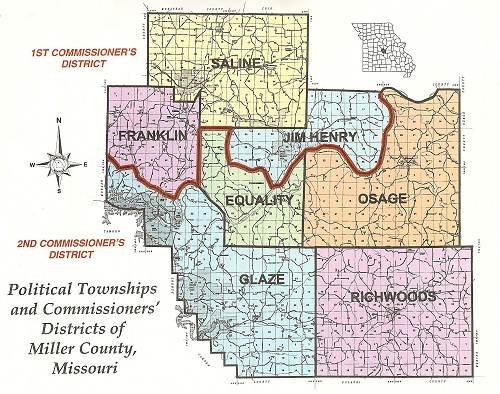
02 Township Map Political
Click image for larger view
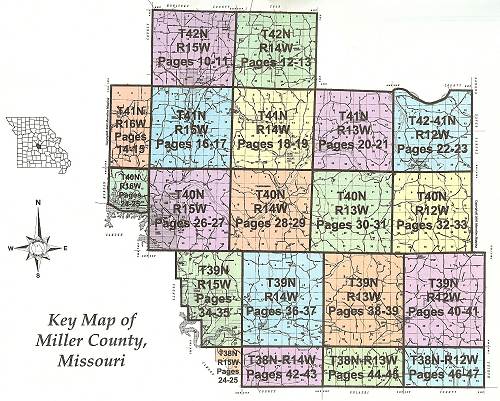
03 Township Map
Click image for larger viewThe topography of the county presents, generally, a broken appearance. The surface is elevated from fifty to 600 feet above the level of the Missouri River at the mouth of the Osage. The latter river runs diagonally across the central part from the southwest, on either side of which are narrow table lands elevated about forty feet above the river, forming the so called Osage bottoms.
From these table lands rise loft bluffs, and broken land rises gradually to the south east, forming the ridge between the Osage and Gasconade, and to the northwest forming the Moreau Osage water shed. In the county the soil varies from rich black alluvial loam in the bottoms to cherty barren soil on the hills and ridges, but most of the land is arable, and when carefully cultivated bears good crops. The Osage River is the most important stream. It is navigable during high water as far as Osceola, in St. Clair County. Its principal tributaries are Little Gravois, Saline, and Jim Henry Creeks from the north, and Bear, Dog, Cat Tail, Coon, Panther, Humphrey and Lick and Tavern Creeks from the south. The Tavern is the largest of these branches, and flows in a devious course from the southeastern part of the county in a northerly direction, its waters are augmented by those of Barren Fork, Sandstone, Bolin and other smaller streams. In the southwestern part is the Grand Auglaize and its feeders, and the northern part of the county is watered and drained by South and Blythe’s Forks of Moreau and East Branch of Brush Creek.
Never failing springs abound throughout the county, some of which are mineral in character and possessing well known medicinal qualities, the best known of these being the Aurora Springs, the Saline and Sulphur Springs. In the northwestern part and south of the Osage are scattered prairie lands, small in extent, but highly fertile. In the valleys of the different streams are extensive timber lands, covered with growths of red, burr and white oak, and white and black walnut, basswood, and woods of lesser value. Not alone are the forest growths confined to the valleys, but in places extend over the higher country. The hills and uplands are excellent for grazing purposes, and much of the territory is well adapted for the growing of fruits, which for many years has been a profitable industry. About 40 per cent of the arable land in the county is under cultivation. The most profitable crops are corn, hay and fruit. Stock raising is an important branch of the farmer’s pursuits. According to the report of the Bureau of Labor Statistics, the surplus products shipped from the county in 1898 were: cattle, 1,260 head; hogs, 10,376 head; sheep, 3,385 head; horses and mules, 76 head; wheat, 633 bushels; hay 98,500 pounds; lumber, 198,700 feet ; piling and posts, 132,000 feet; cross ties, 984, 963; cordwood, 1,185 cords; poultry, 295, 531 pounds; eggs, 109,650 dozen; butter, 8,249 pounds; dressed meats, 1,406 pounds; game and fish, 12,471 pounds; hides and pelts, 9,945 pounds. Other articles exported from the county were feathers, furs, molasses, dried fruits and fresh fruits, lead ore and tiff and vegetables. In the southeastern and western parts of the county bituminous coal has been found. There are also hematite and specular iron ores, zinc and lead. For the past quarter of a century, at times, lead has been profitably mined, and the mineral interests of the county promises to become important, as within the past few years there have been greater activity and system in development work. There is abundant lime and sandstone, excellent for building purposes. There are a few caves in the county, the largest of which is on Big Tavern Creek, near its confluence with the Osage. Its entrance is about twenty five feet square and about thirty feet in the bluff above the river bed, and is reached by a ladder. During the Civil War it was a retreat of Crabtree, the so called bandit (photo 05).
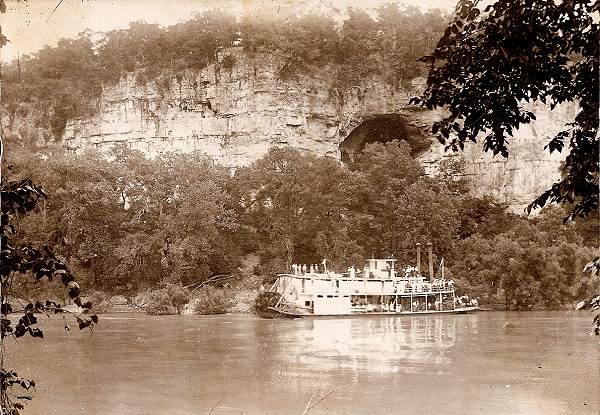
05 J.R. Wells at Bat Cave Further up the Tavern are two other caves, one of which for several years was used as a beer vault by a German who established a small brewery there. On the bluffs of the Osage and Grand Auglaize are numerous stone mounds of some prehistoric race. In these mounds have been found quaint bits of pottery, charcoal, stone axes and other relics. On the Osage bottoms are regularly arranged earth mounds, similar to those in the eastern part of the State along the Mississippi River. The territory now comprising Miller County was a hunting ground of the Osage Indians, and as late as 1822 they had a village on Tavern Creek, near the mouth of Barren Fork.
About the beginning of the century (perhaps before) adventurous hunters and trappers visited the country, and later traders followed in their footsteps.
Along the Osage River was a well worn trail, and along this the pioneers wended their way, now and then following up the branches of its tributaries. It is not known that any of the early hunters in the territory became permanent settlers. The first white man to make his home in the county, according to the most reliable authorities was Seneca R. Y. Day, who settled near the mouth of Tavern Creek in 1815. In 1819 A.J. Lindley located also on Tavern Creek. Little of their personality is known, and tradition fails to tell whence they came or whither they went. The next to become residents of what is now Miller County were two brothers, William and Boyd Miller (photo 08), who took up their residence in the northeastern part, on Spring Garden Prairie.
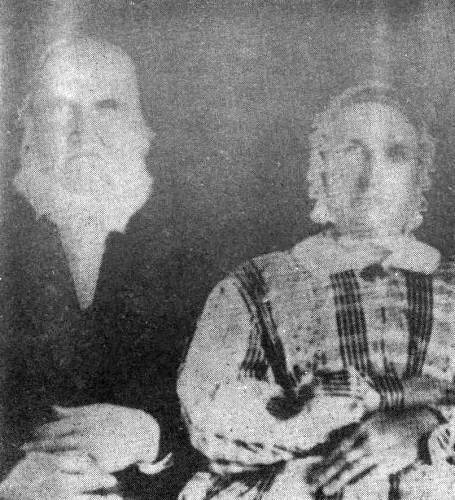
08 William and Sarah Miller John Wilson, an eccentric character, in 1822, located on Tavern Creek, near the mouth of Barren Fork. He was a native of Ireland, and was about sixty five years old when, with his wife and family, he became a resident of what is now Miller County. The first winter they made their home in a cave, which has since been named “Wilson’s Cave” (photo 09).
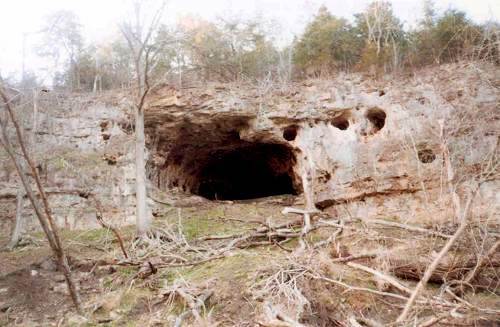
09 Wilson Cave He was friendly with the Indians, and his start in stock raising was with pigs which they donated to him. When later settlers occupied the country the name “Cave Wilson” and Uncle Jack” were applied to him, and his wife, a noble little woman, became known as “Aunt Nellie.” Wilson was fond of the hunt, and as years passed became known as an extensive landowner and a man of wealth. He was a lover of nature, held the views of a free thinker, and his generosity was only bounded by his resources. He was a man of sterling worth and a contemporary neighbor paid him a just tribute by saying, “He fed the hungry, visited the sick, and clothed the naked.” He lived to be 100 years old, dying in 1855. Long before his death he prepared a coffin for himself, which he placed in a small cave near the cave in which he once lived on Tavern Creek, and when his end came, according to his oft expressed wish, in this cave was placed his body packed in salt, and near by a demijohn of good whiskey, and the cave sealed up. He directed that at his funeral a good dinner and “something to wash it down” be served to all who attended, and at the end of seven years the natural tomb be opened and his friends meet there and partake of the contents of the demijohn. Many seven year periods have since passed, and still the demijohn and tomb remain undisturbed, but the good deeds and eccentricities of this man will long be a matter of tradition in Miller County.
About 1830 Maston Burris, Samuel Richardson, John Brockman, Hugh Challis and Isaac Bass settled on the Osage, and Daniel Brumley and Isaac Bilyeu on Tavern Creek. Later came the Wilkes, McCaslin, Sullins, Moore, Spence and other families, who settled in the vicinity of the present site of Eldon; and the Hines, Simpson, Stubblefield and Harrison families settled in the locality of Spring Garden. After 1830 settlement rapidly increased. The first person to make an entry of land in the territory, now Miller County, was William Miller, his entry dating July 20, 1826. In 1829 David Johnson, John Greenup, E. Wilkes, Stephen Bell and others filed on land. Between 1830 and 1840 many settlements and entries were made. The earliest settlers paid more attention to hunting and trapping than to farming, which was not started until after 1830, only sufficient “garden truck” being raised for the individual needs of families, as the forests and streams supplied abundance of game and fish for food. As in other frontier counties, the mortar and pestle were used in preparing corn for bread, and these were replaced by horse mills, which were used until 1834, when William Brockman built the first mill in the county to be run by water power on Saline Creek, and on the same stream, a few years later, William Williams built the second mill in the county. The first mill to be run by steam power was built in 1853 by John Humes, near Pleasant Mount.
Note: for a complete list of Miller County mills click here.
Miller County territory was included in Cole County when the latter was organized in 1820, and remained so until February 6, 1837, when the legislative act creating Miller County out of the southern part of Cole County was approved. Its boundaries were again defined in 1839, the line between Camden and Miller Counties changed in 1845, territory from Morgan County annexed in 1860, and again minor changes were made in 1868. The county was named in honor of John Miller, who was Governor of Missouri, 1826-28.
The Legislature directed that until a permanent seat of justice be selected, the court meet at the house of John Miller, the name “John” being an error, William Miller being intended, and David Fullbright, of Pulaski, Zacheus German, of Morgan, and John Hensley, of Cole County, were appointed commissioners to locate a seat of justice. The first county court was composed of John Francis, presiding justice, and Edmund Wilkes and Stephen A. Blevans, associate justices. James P. Harrison was the first clerk of the court, and William M. Harrison the first sheriff. The first session of the court was held May 1, 1837, in a log house located near the mouth of Saline Creek, and occupied by William Miller. The second term of court was held at the store of J.P. and J. B. Harrison, located on land which now constitutes the present site of Tuscumbia. James P. Harrison donated to the county a tract of land for county buildings, which was surveyed in July, 1837, by Marquis Calmes, the first county surveyor. An acre and a half was reserved for a public square. Town lots were sold in October following, and the money derived from the sale was placed in a fund for the erection of county buildings. The following year a one story log courthouse was built, at a cost of $975, and was occupied in 1839. A log jail, one story, 19X19 feet, was built. In 1859 the log courthouse was replaced by a two story brick building, 40X56 feet, at a cost of $7,500 (photo 11), and in 1865 the log jail was replaced by a stone building.
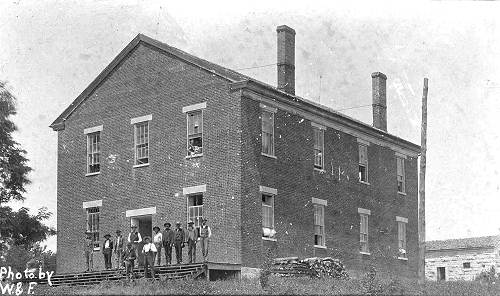
11 Old Courthouse - 1859
Click image for larger viewIn 1895 the present jail was built at a cost of $500. The first marriage ceremony in the county was performed by Reverend Andrew Kingrey, “a preacher of the Gospel,” who united in marriage Sims Brockman and Rachael Garten, May 6, 1837. The first session of the circuit court for Miller County was held in the house of William Miller, on Thursday, June 22, 1837, Judge William Scott presiding, James P. Harrison, clerk, and William M. Harrison, sheriff. The members of the first grand jury were: John L. Davis, foreman; Robert Shipley, William P. Dixon (photo 12), Samuel Miller, Isaac Bass, Elisha Francis, Elihu Gregory, John G. Witten, James Brumley, William Blyze, John Stewart, John Hale, John Shelton, Peter Sullens, Leander Musick, Abraham Castleman and John L. Loveall.
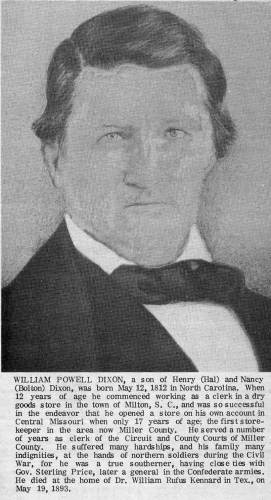
12 William Powell Dixon
Click image for larger viewThe first case was an appeal from a justice court, Oliver O. Neal vs. Richard W. Taylor, for trespass. The defendant was found guilty and the plaintiff awarded one cent damages. The first divorce case was Lucinda Anderson vs. James Anderson, in 1838. The first indictments were returned in 1839, when John Posten and Charity Baldridge were indicted for adultery. The first commitment to the penitentiary was not until 1850, when one Carter, found guilty of horse stealing, was sentenced, and after serving his term was driven out of the county by citizens. Until that time cases of robbery, forgery, etc., were unusual in the county. The first trial for murder was in 1853, the accused being Boyd M. Roark, and he was found “not guilty.” For more than half a century there was no capital punishment inflicted in the county. There were a number of trials for murder, but in cases where the parties were found guilty they were sent to the penitentiary. The only members of the bar who resided in the county prior to the war were D. Fletcher Martin, who was admitted to practice in the county in 1855, and Sidney Challis. Martin enlisted in the Confederate Army at the outbreak of the war and did not return, and Challis died a few years after he began practice. While among the early settlers many were church members, there were no regular religious services held until 1830, when two Baptist preachers, John Abbott and Jacob Chism, preached to believers in the faith at their different homes. A few years later the Missionary Baptists began holding meetings, conducted in private houses by Andrew McCaslin, Blueford Scott and Andrew Kingrey.
Following these came ministers of the Methodist Episcopal and Christian Churches. About 1840 Mount Vernon Church was built by the Missionary Baptists, the first building in the county dedicated to religion. The Missionary Free Will and Primitive Baptists, the Congregational, Christian, Presbyterian, Cumberland Presbyterian, Methodist Episcopal, both North and South, United Brethren, Catholic and Holiness Band denominations now have churches in the county. There were no schools in the county until after 1830. Among the first teachers, if not the first, was J.M. Houston (photo 13), a lay preacher, who opened a school on the Wilkes farm, near Rocky Mount.
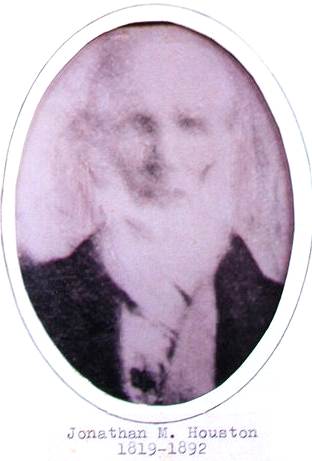
13 Jonathan Milton Houston Others among the early teachers were Judge Hiram Reed, Silas Capps, Meredith Bowman and Elisha Glass. In 1840 the county court organized the county into fourteen districts. District No. 10 was the first to organize under the act of 1845. In 1858 there were forty three districts in the county, fourteen schoolhouses, twenty two teachers, and 926 pupils. The report of the school superintendent in 1899 showed the number of public schools in the county eighty six, with 101 teaches, 5,476 pupils, and a permanent school fund, township and county, of $39, 175. There are four good private school in the county, the Iberia Normal School, started in 1888; the Miller County Institute, established in 1870 (photo 14); the Miller County Academy, founded in 1881, and the Eldon Academy, established in 1886.
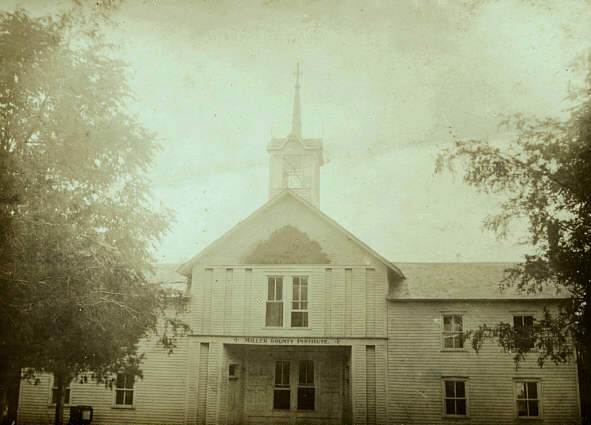
14 Miller County Institute The first newspaper was issued in the county in 1870, at Tuscumbia, by Lemmon & Hitchcock. About 1875 it was removed to Richland, Missouri. In 1871 M.W. Gustin started the “Republican.” The present press of the county is represented by the “Autogram” and “Eye Opener,” at Tuscumbia; the “News,” at Olean; the “Advertiser,” at Eldon, and the “Intelligencer,” at Iberia.
During the Civil War, Miller County supplied about 1000 men to both sides, about 700 serving on the Federal side and the remainder on the Southern, mostly under General Parson. There was considerable bush whacking, a little skirmishing but no regular engagements within its limits. In 1864 Price’s Army passed through the northern part of the county. The county quickly recovered from the effects of the war soon after peace was declared. The slaves in the county in many cases remained with or settled near their old masters, and those that did not leave engaged in farming. Miller County is divided into seven townships, named, respectively, Auglaize, Equality, Franklin, Jim Henry (named after an old Osage Indian chief), Osage, Richwood and Saline (see photo 02 above). The assessed value of real estate and town lots in the county in 1899 was $1,603,933; estimated full value, $3,903,640; personal property, $793,155; estimated full value, $1,077,445; merchants and manufactures, $125,945; estimated full value; $251,880; assessed value of railroads, $99,052.22.
About twenty miles of the Jefferson City & Lebanon branch of the Missouri Pacific Railroad passes from north to south through the western part of the county (photo 15).
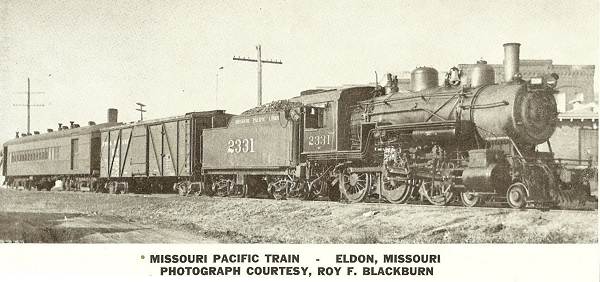
15 Missouri Pacific Train The population in 1900 was 15,187.
We have some photos in our Civil War display at the museum which are of groups of older men with the captions stating they are members of the GAR. Many visitors ask me what the abbreviation GAR represents. The abbreviation is for the words ‘Grand Army of the Republic’ an organization formed after the Civil War not only for camaraderie among former soldiers who fought in the Civil War but also organized for the purpose of community service. So I am going to copy here a narrative explaining the history and purpose of the organization which I found in the book, Encyclopedia of The History of Missouri by Howard Louis Conard, the same author who wrote the Miller County history presented just above in this week’s Progress Notes. The narrative was written long enough ago (1890’s) that the author had ample opportunity to interview many former soldiers of the Civil War who had joined the GAR. Here is what he wrote:
Grand Army of the Republic
Encyclopedia of the History of Missouri
Howard Louis Conard
A secret order composed of persons who served in the Army and Navy of the United States in the Civil War, its object being to preserve and strengthen fraternal feeling among its members, encourage loyal sentiment, bury the dead of the society with becoming honors, maintain the observance of May 30th as Memorial Day, by visiting cemeteries and decorating the graves of buried patriots with flowers, and to furnish assistance to needy veterans’ families. The order owes its origin to B.F. Stephenson, surgeon of the Fourteenth Illinois Volunteer Infantry. The first general orders were issued April 1, 1866, a year after the close of the Civil War, and the first post was organized April 6th of that year, at Decatur, Illinois, and a national organization effected at a convention held at Indianapolis in November following. The first twelve charter members all served in Illinois regiments. The motto of the order is “Fraternity, Charity and Loyalty.” Party politics are forbidden in its discussions. The constituted bodies of the order, beginning with the lowest, are: First, a local organization, known as Post No. ----: second, a State organization known as a Department; and third, a national organization known as a National Encampment of the Grand Army of the Republic. The supreme power is lodged in the National Encampment held every year. Each post has a relief fund, and no needy member is allowed to go unassisted. The observance of Memorial or Decoration Day is scrupulously maintained. On the Sunday preceding the day, the posts attend church, and if any member has died during the year, a memorial service is held; and when the 30th of May arrives, all join in orderly processions to the cemeteries where departed loyal soldiers lie buried, and deposit wreaths and bunches of flowers upon the graves. The membership of the order reached its highest point in 1892, when there were 409,489 members in the United States. At the first national convention, held at Indianapolis in 1866, Missouri was represented by a body known as the “Volunteer Mutual Aid Society,” which was there merged into the Grand Army of the Republic; but the new organization did not prove fortunate at first, and after a while passed out of existence. In 1874, Abraham Lincoln Post No. I was organized in St. Louis but it was a failure also, and in two years was abandoned. Finally on the 8th of December 1879, a meeting of ex soldiers of the Union Army was held at St. Louis in the office of ex Governor Thomas C. Fletcher, which brought about, the following month, the organization of Frank P. Blair Post, No. I, with John Reed, Thomas R. Rodgers, S.O. Fish, John W. Francis, R.B. Beck, G. Harry Stone, John O’Connell, John B. Pachall, F.R. Potter, George C. Chase, Richard Mallinckrodt, E. M. Joel, B. Seaman and Arthur Dreifus as charter members. April 22, 1882, a State convention of delegates from all the Grand Army posts in Missouri was held at Kansas City, and the Missouri Department of the Grand Army of the Republic was organized, with Major William Warner as department commander. The next year he was reelected, and during the two years of his administration the membership of the department increased from 500 to over 6,000. At the beginning of the year 1900 the order had an organization in 107 counties in Missouri, with 415 posts and 17,543 comrades, there being in St. Louis nine posts and 2006 comrades; in Kansas City three posts and 697 comrades, and in St. Joseph one post with 207 comrades.
Here are some photos of the attendees to GAR encampments in Miller County which occurred in the early part of the last century. The first photo is of the Brumley GAR (photo 16).
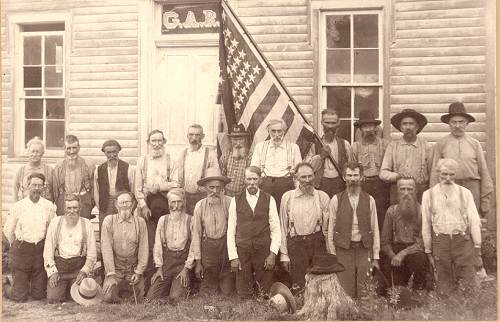
16 Brumley GAR
Click image for larger viewHere is the caption for the Brumley GAR photo:
Front Row: first man on left is James Martin Hawkins (1847-1934), 6th man is James Lewis Pemberton (1845-1931),10th and last man is James Mastin Wornell (1843-1932).
Back Row: 3rd man from left is Emanuel Lett or Jett (a black man). The man in the white shirt standing in front of the flag is Henry Clay Jackson (1839-1932).
The second photo is of the Eldon GAR (photo 17):
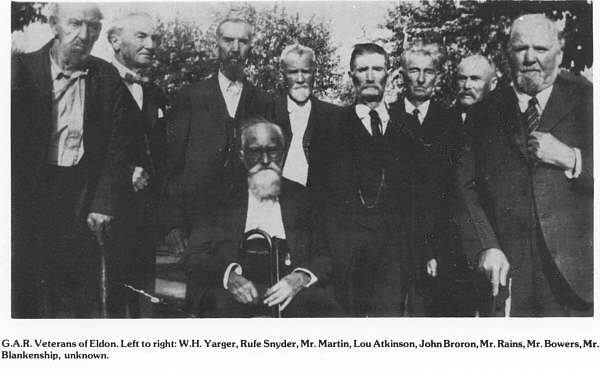
17 Eldon GAR The third photo is of the Iberia GAR (photo 18):
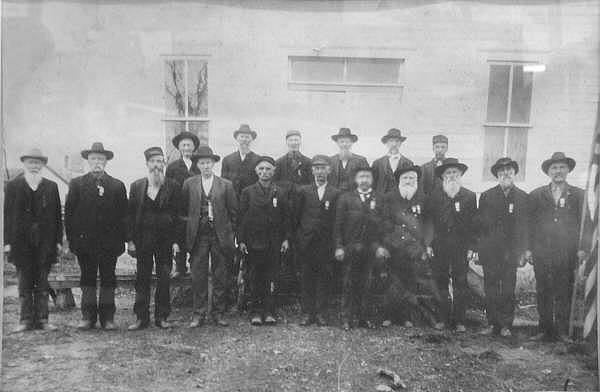
18 Iberia GAR Here is the caption for the Iberia GAR:
Front Row L-R: Jim Berry, James Cross, Jerry Fallman, Epaminandos Deampird (E.D.) Hays, Steven Deardeuff, Simon Deardeuff, John Ferguson, Thomas Marchant, Absolom Bear, John Carroll
Back Row: Benjamin Fike, John E. Dickerson, George Teaverbaugh, Joe Crismon, William C. Thompson, John Brown.
Absolom Bear, second from the right of the first row, was my great great uncle, being a brother to my great grandfather, David Christian Bear.
In Miller County, the Iberia GAR encampment (an annual festival similar to a fair or picnic) was one which persisted through the years. This in no small manner was due to the efforts of Squire John Ferguson (photo 19), one of Miller County and Iberia’s most colorful personalities.
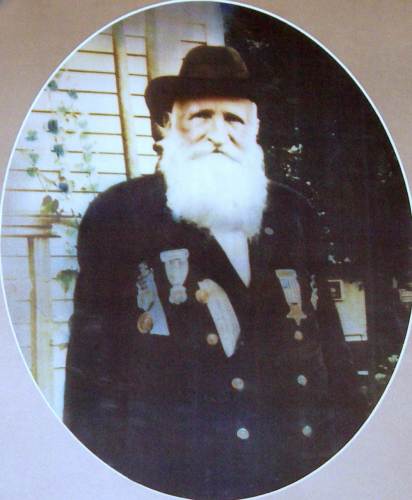
19 Squire John Ferguson An article was published in the Jefferson City Tribune shortly before Squire John died, probably around 1937 (I don’t have the date listed on the newspaper clipping) which describes one of the later Iberia GAR encampments:
Iberia Encampment Which Closed Last Night Has Rich History in 60 Years
The Sunday News and Tribune
Jefferson City, Mo.
Date September 13, approximately 1937
IBERIA, MO., SEPT. 13
This is a story of yesteryear. A story of color and tradition that has changed somewhat as years and the customs have passed by; but one that has survived and will continue to remain with the tenacity of ivy clinging to a brick wall, in the hearts and minds of all Iberians and their future generations forever, and until the day after forever.
As this is being read, towheads will be slumbering blissfully, dreaming of Ferris wheels and merry go rounds; of rides and eats crammed into that one last hour of this year’s long looked forward to annual Encampment, which to them spelled excitement and emptiness of Dad’s pocket book.
This fact in itself means comparatively little to the average public. Small town picnics are a common trend of the day. The real drama of this story lies in the background. The active colorful imagination may easily go with me to about the year of 1886 when Iberia was commonly known as “Rocktown.” A quiet, little village with a brave pioneering spirit, situated among the many hills, trees and rocks that in their way helped it to survive the many trials and handicaps that must have come to it as it struggled for endurance so far from a railroad and so far in the backwoods.
It was about 60 year ago that five different posts under sponsorship of the G.A.R. met and organized what was then and still is known as the Miller County Encampment, but which has more popularly drifted down to “Iberia Encampment.” Richland, Brumley, Eldon, Tuscumbia and Iberia were the posts first sharing in the honor attributed to the worthy organizations, but one by one, different posts dropped out for one reason or another, until only Iberia is left to uphold the principals upon which it was founded and carry on the traditions of the forefathers who founded it. As far as history seems to recall, or local memories either, the founder of the affair was one of Iberia’s most prominent citizens of the day, “Squire Ferguson” (photo 20) father of Harry and Frank Ferguson, and Mrs. G. M. Martin, who still resides here in Iberia.

20 Iberia Encampment
Click image for larger viewFred Spearman, veteran of World War I, can hand out the tips on the whole thing through, perhaps better than the average Iberian, as he has placed certain facts and dates in his memory that are not to be denied. Fred can still bask in the shade on the long old fashioned bench just outside Adams’ store here, and chat eagerly with you about the occurrences of that period.
It was about 60 years ago according to him, that the first encampment was established and held. Which post acted as host to the first shindig is beyond his recollection, but he surmises it was Iberia, because of “the fact he was just about “so high” when it started, and his parents lived then where the Johnny Pemberton farm, six miles west of Iberia now is located.
He reports a fairly huge beef, donated by combined posts, was killed, butchered, and distributed to poor families ‘gratis.’
As most memories recall, the now popular rides and concessions were a thing unknown. Each night as the crickets and jar flies hummed a sleepy lullaby and the frogs caroled down by the water (camp was often made by Big Tavern Creek just south of here between Iberia and Crocker) a huge bonfire was kindled and around its glowing embers veterans and their families and all other campers who had come prepared to “stay out” the four days gathered. Then, as prominent as the glorious red, white and blue which adorned the front of each tent, came a speaker especially selected for the occasion.
Ofttimes, if a speaker was unavailable, the veterans took turns at relating their most interesting experiences. Camp was always located in the woods or away from town so would be sleepers were undisturbed.
A parade occasioned the beginning of each day’s events and as flags waved and drums and bugles sounded, the entire countryside from ‘Gramma and Gramps to Aunt Agatha and Sister Sue cheered and kept time to the pulsating rhythm of the popular drum and bugle corps.
The event was usually held the latter part of August when the crops were laid by and the sorghum not quite ready for the making. Hearts were light and the feet lighter that stepped lively to the merry tunes that swept nimbly the sure footed boys and girls of the late 1800’s on to the first dance floor introduced at these encampments.
This was along about the middle of the nineties and was far from the era of jazz and swing that marks our day. This was the day of the swish and rustle of taffeta; this was the day of buttoned shoes and the high piled hair. And no less the dandy was the polished gentleman who danced with his blushing lady friend as they bent and swayed to the rhythm of “Leather Britches” and “Goin’ Up Cripple Crick.” These were the tunes and these were the dances that originated from the country homes. The same log cabin homes from whence came the fiddlers who really lived their fiddling, as the bow that had probably come up and over the Blue Ridge mountains, wept and mourned its way through the “Waltz You Saved For Me.”
Reminiscent of the Daniel Boone era and the coon skin cap were the long brown muskets displayed at that long ago shindig, and merry were the hearts as the group singing enjoyed around the campfire, faded into a prayer of thanksgiving each evening for life, liberty, and the pursuit of happiness.
And as this weekend marked the closing of another festival held in honor of those long ago days and the ones who instituted it, youngsters shall awaken to hear again the history of that time and the founders, and to each succeeding local generation it will mean another tally to mark on their calendar of memorable events.
As noted in the article above, Squire John Ferguson was the most active and enthusiastic Miller Countian GAR member.
He always was very active in Iberia and Miller County public affairs. For many years he was chairman of the Village Board of Trustees of Iberia and for over fifty years was justice of the peace. He played an important role in the celebration of the opening of the new 1933 bridge across the Osage River at Tuscumbia and was the main speaker at the 1937 Miller County Centennial Celebration in Tuscumbia.
He was a charter member of the Miles Carroll Post Number 111 of the G.A.R. and was commander of the post beginning in 1885. On May 16, 1928, he was elected Department Commander of the G.A.R. of the State of Missouri. He attended all of the National G.A.R. encampments since the time of its organization, with the exception of one or two, when illness prevented. The trips to the national encampments took him as far east as Portland, Maine, and as far west as Portland, Oregon.
Here are some photos of him where he attended GAR sponsored events (photos 21 and 22):
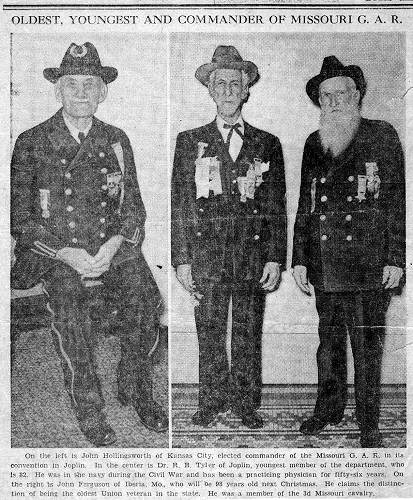
21 Oldest and youngest members of GAR
Click image for larger view
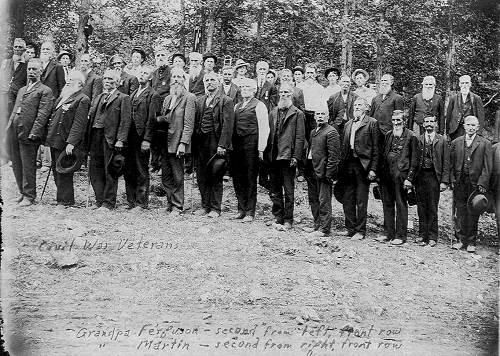
22 Civil War Veterans
John Ferguson 2nd from Left - George Martin Father 2nd from Right
Click image for larger viewYou can read more about the Miller County GAR on our own website.
Debbie Simmons of Eldon a few months ago sent me some photos of one of Miller County’s most beautiful springs, Ratcliffe, which is located north of Eldon. Years ago in 1855 a man named Jess Ratcliffe petitioned the Miller County Circuit Court for a legal document declaring him sole owner of the spring and surrounding area. Here is Clyde Lee Jenkins’ description of that event taken from our own website:
RATCLIFFE'S MILLS
Clyde Lee Jenkins
In February, 1855, Jesse Ratcliffe petitioned the Miller Circuit Court for a writ of ad quod damnum, which was granted under seal of the Court, and issued to the Sheriff of Miller County.
Ratcliffe's petition declared himself the legal owner of a certain tract of land situated in Miller County, purchased by him from the United States, described more particularly as the N 1/4 of lot 2 of SW 1/4 Section of Section 7, Township 42 N., Range 15 W, through which a water course passed at or near the Southeast corner, known as the South Moreau Creek.
Ratcliffe proposed erecting a dam seven feet and six inches in height across this creek to run a grist and saw mill, the houses and machinery to be erected on the easterly side of the stream. John Comes, a resident of Morgan County, being the owner of the land on the westerly side of the stream, made action by the Court necessary in order for him to attach his dam upon it.
Twelve disinterested persons, summoned, sworn by the Sheriff, and empanelled as a jury, met at the proposed site on April 8, 1856, inquiring upon the matters touched by the petition. Afterward, Ratcliff's mills commenced running and continued in operation many years.
And here are a couple of photos Debbie sent me, one of the spring pond and one of the creek runoff (photos 24 and 25).
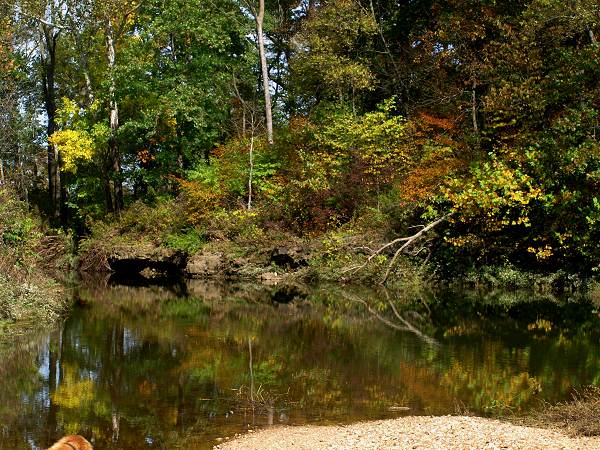
24 Ratcliffe Spring

25 Ratcliffe Spring Creek
That’s all for this week.
 Joe Pryor
Previous article links are in a dropdown menu at the top of all of the pages.
|

